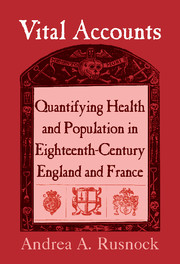Book contents
- Frontmatter
- Contents
- List of Illustrations
- Acknowledgments
- Vital Accounts
- Introduction
- 1 A New Science: Political Arithmetic
- PART ONE SMALLPOX INOCULATION AND MEDICAL ARITHMETIC
- PART TWO MEDICAL ARITHMETIC AND ENVIRONMENTAL MEDICINE
- 5 Medical Meteorology: Accounting for the Weather and Disease
- 6 Interrogating Death: Disease, Mortality, and Environment
- PART THREE POLITICAL ARITHMETIC
- Conclusion
- Bibliography
- Index
- Titles in the series
6 - Interrogating Death: Disease, Mortality, and Environment
Published online by Cambridge University Press: 15 October 2009
- Frontmatter
- Contents
- List of Illustrations
- Acknowledgments
- Vital Accounts
- Introduction
- 1 A New Science: Political Arithmetic
- PART ONE SMALLPOX INOCULATION AND MEDICAL ARITHMETIC
- PART TWO MEDICAL ARITHMETIC AND ENVIRONMENTAL MEDICINE
- 5 Medical Meteorology: Accounting for the Weather and Disease
- 6 Interrogating Death: Disease, Mortality, and Environment
- PART THREE POLITICAL ARITHMETIC
- Conclusion
- Bibliography
- Index
- Titles in the series
Summary
I propose …, in imitation of the geographers, to spread out and to review, in one general Chart, the enormous host of diseases which disgorge their virulence over the earth, and with frightful rapacity, wage incessant hostilities with mankind. By this means, we shall, to use a military phrase, reconnoitre more distinctly our enemies arranged in hostile front; and be warned to make the best disposition and preparation for defence where the greatest danger is apprehended, and the most formidable assaults to be sustained.
William Black (1789)Death emerged as a topic of quantitative study during the long eighteenth century. Individual mortality had, of course, always been a subject of contemplation as had experiences with epidemics, famine, and war. The plague especially led many to reflect on the causes and repercussions of great mortalities, but there was little systematic inquiry of death prior to the eighteenth century. One reason for this absence might be the fatalism that much of European society attached to death. Death had been tamed in European culture in the sense that society accepted death as a constant and certain companion of life. Cemeteries, for instance, were immediately adjacent to churches and were in themselves social gathering places. During the eighteenth century, however, individuals began efforts to separate the living from the dead; they moved cemeteries to the outskirts of town; they prohibited burials in churches. They increasingly used coffins and embalming to hide, deflect, or distance themselves from the process of physical decomposition.
- Type
- Chapter
- Information
- Vital AccountsQuantifying Health and Population in Eighteenth-Century England and France, pp. 137 - 176Publisher: Cambridge University PressPrint publication year: 2002



